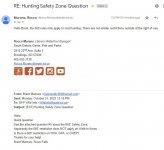Weimdogman
Well-known member
So I am no fan of mowed /grazed wia(or any public ground) but the reality is all ground has to be managed.
As for S.D. most of the state is in a multiple year drought and that hay is needed. I do dislike it but better to cave in and let them hay then to have them pull it out of wia and then hay it.
I know of 1 wia that hasn't been huntable for pheasants in 6 years. Person could try and hunt waterfowl or dove or deer so....
1 very good wia came out 2 years ago. I wrote a email chiding the state for losing a very good wia. A wia that got used by pheasant hunters ,duck hunters,archery and rifle deer hunters. It is now once again wia.
I talk to the Co here and do tell him about these wias. I also tell him about what I see when hunting. River otters can be found in some funny places and they want to know about them. Birds like Sandhill cranes and tundra swans aren't native but are coming around more often. The co wants to know where they are.
Yesterday I hunted a wia that has been partially hayed. It will be in the future also as a small field is alfalfa. There is native grasses sedge and cattails in the balance. A little waterway has some willows and other smaller trees. Maybe 40 acres total.
I saw 7 roosters and 6 hens!
Corn field on 1 side is still in and it has a great continuation of the waterway. So this wia may only get better!
As for S.D. most of the state is in a multiple year drought and that hay is needed. I do dislike it but better to cave in and let them hay then to have them pull it out of wia and then hay it.
I know of 1 wia that hasn't been huntable for pheasants in 6 years. Person could try and hunt waterfowl or dove or deer so....
1 very good wia came out 2 years ago. I wrote a email chiding the state for losing a very good wia. A wia that got used by pheasant hunters ,duck hunters,archery and rifle deer hunters. It is now once again wia.
I talk to the Co here and do tell him about these wias. I also tell him about what I see when hunting. River otters can be found in some funny places and they want to know about them. Birds like Sandhill cranes and tundra swans aren't native but are coming around more often. The co wants to know where they are.
Yesterday I hunted a wia that has been partially hayed. It will be in the future also as a small field is alfalfa. There is native grasses sedge and cattails in the balance. A little waterway has some willows and other smaller trees. Maybe 40 acres total.
I saw 7 roosters and 6 hens!
Corn field on 1 side is still in and it has a great continuation of the waterway. So this wia may only get better!


